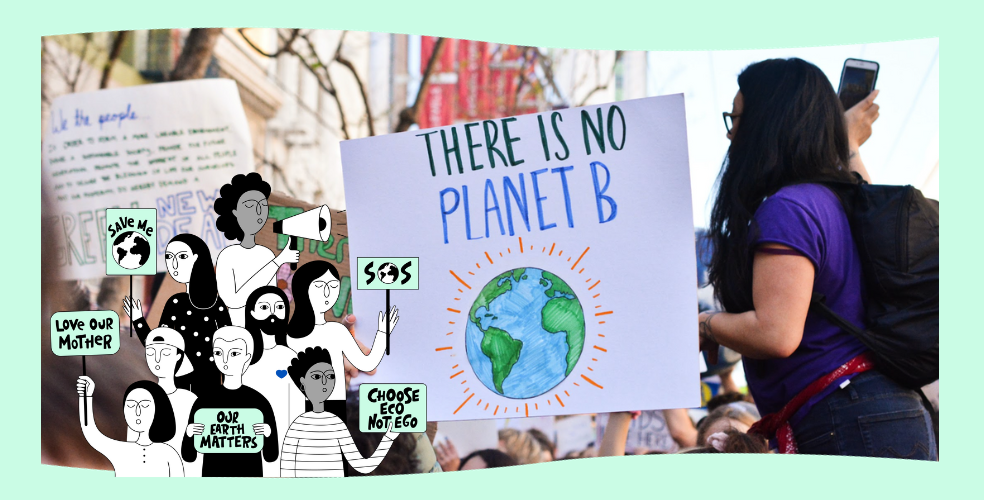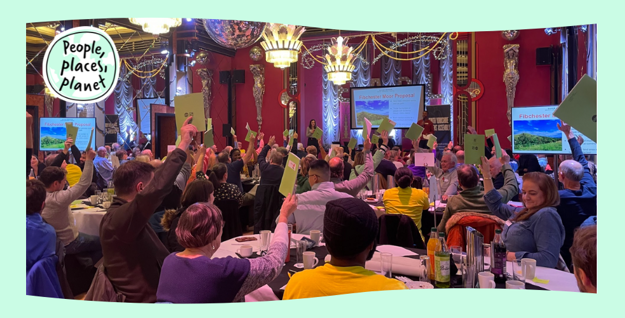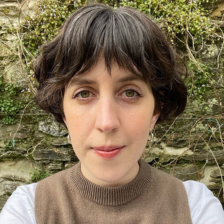Over the past six months, we’ve worked with South Yorkshire Mayoral Combined Authority (SYMCA) to design and deliver a citizens’ assembly on Climate Change. An initiative of Mayor Oliver Coppard, the assembly was the first regional event of its kind in the UK – taking place across Sheffield, Rotherham, Doncaster and Barnsley.
If you’re not familiar with the format, a citizens’ assembly is a deliberative democratic process in which a group of citizens come together to learn about and discuss an issue before making a set of recommendations about what they think should happen. A process called sortition is used to randomly select a group of demographically representative participants. This gives the assembly legitimacy and ensures that participants reflect a range of views on climate change, from sceptics to activists.
In South Yorkshire, over 100 participants came together for 30 hours across four weekends to address the following question:
"The way our climate is changing will impact us all. How should we respond to build a thriving and sustainable future for South Yorkshire?"
30 contributors from across the region were invited to present evidence from a range of perspectives within the themes of:
-
place,
-
health and wellbeing,
-
mobility
-
work.
In response, participants produced a longlist of ideas to deliberate on and prioritise before forming a final set of 14 key recommendations.
We’ve now delivered citizens’ assemblies on climate change in Blackpool, Barnet and South Yorkshire, and want to share how we applied what we’ve learned about how to design the process to have the most impact.
Understand the context
Citizens’ assemblies on climate change tend to have a strong connection to place, so it’s important to understand the local context before you jump into designing the process.
In South Yorkshire, we held research sessions with key local stakeholders to help us understand why the assembly was needed, what had happened before and what different groups hoped it might achieve. These sessions helped us identify early on where people agreed on the assembly’s aims and where further work might be needed. They enabled us to gain valuable insight into the most relevant and urgent issues around climate change in the region from those on the ground. Finally, they gave us routes into connecting with the people, organisations and networks already operating in the space, many of whom we went on to invite to contribute to the process.
Scope the topic carefully
Climate change is a huge systemic issue that touches on every aspect of our lives. Understandably, commissioning organisations are often keen for an assembly to address as many topics as possible, given the huge investment of time and resources they have committed.
However, it’s important to define the scope of your assembly carefully, to make sure you can design a meaningful learning journey in the time you have available.
When you think about it, 30 hours isn’t a long time – particularly when participants have such a wide range of starting points. If you try to cover too much ground, people can struggle to keep up, ultimately impacting on the quality of recommendations. So we held design sessions with SYMCA early on, to collectively prioritise four key themes we wanted to explore based on what we’d learned in our initial research sessions. This made sure our learning journey was considered, concise and firmly rooted in the context of South Yorkshire.
Combine different forms of knowledge
As you design your learning journey, it’s important to include different forms of knowledge. Citizens should be active participants in the production of knowledge rather than viewed as ‘empty vessels’ waiting to be filled. Before bringing in ‘experts’, your starting point should always be: what knowledge do we hold in the room?
In the first session of the citizens’ assembly, we asked participants to draw a picture and write a postcard from a thriving and sustainable South Yorkshire, offering a creative means to explore and share what these words might mean to each of them. When inviting contributors, we included diverse voices that brought together academic and technical expertise with community-based knowledge and lived experience. This helped to acknowledge and overcome the gap between policy making and people’s lived realities.
Build on what’s already happening
In very few cases do we need to come up with brand new solutions that nobody has ever thought of before – especially in the climate space. Often the problem is that people aren’t aware of what’s already happening, what’s working and what’s needed to move that work forward.
We invited contributors across health, education, agriculture, business, academia, community organisations and government to share a series of case studies. Contributors were briefed to share not only what was working, but what wasn’t – the challenges they’d faced, what they’d learned along the way, and what was holding them back from scaling their work. Participants had the opportunity to ask questions and reflect on what they’d heard. Although they were able to come up with their own ideas too (and many did) most people find a blank piece of paper challenging. Ultimately, this supported citizens to put forward a more robust set of recommendations that acknowledged and built on what had come before.
Focus on the ‘how’ of climate policy
In the five years since the first citizens’ assembly on climate change in the UK, the policy landscape and tone of national debate has changed dramatically. We are living in a crucial decade for action to address climate change and meet the UK’s legally binding commitment to reach net zero by 2050, yet at the same time this feels harder than ever.
We designed the South Yorkshire citizens’ assembly against the backdrop of local elections where the divisive extension of London’s Ultra Low Emissions Zone (ULEZ) took centre stage.
This helped us reflect that where we might already have many of the solutions to address the climate crisis, there’s a lack of consensus on how to enact climate policy in a fair and equitable way, making change difficult. This is where Citizens’ Assemblies can have the greatest impact – so we asked participants:
-
which ideas that you’ve heard resonated with you?
-
how might you adapt them to work better for you, your family or your community?
-
under what conditions would you accept this change?
This moved the conversation on from one focused on a vision for a more sustainable South Yorkshire to a more nuanced exploration of how that might be delivered in practice.
Engage with trade-offs
Solving the climate crisis isn’t as easy as coming up with good ideas, and too often citizens’ assemblies on climate change fail to engage with the most important part of the debate: trade-offs.
These are the things that keep politicians and elected officials up at night. From deciding which issues are the biggest priority now, to how to spend a finite pot of money. The format of citizens’ assemblies can sometimes make this kind of deliberation challenging, especially when you are working with a large and diverse group of people on a topic as complex as climate change.
To combat this, we designed a series of participatory ‘trade-offs’ activities into each of our thematic sessions to encourage citizens to start thinking through these challenges. These often took the form of hypothetical scenarios where participants had to make quick decisions together whilst considering the impact of those decisions elsewhere. Later, we saw this way of thinking coming through in the deliberations. A memorable example saw the room engaging with the trade-offs between installing solar panels on farmland, and the need for locally produced food.
Don’t lose sight of outputs and outcomes
As they gain popularity across the world, citizens’ assemblies run the risk of becoming overly focused on the process while neglecting the importance of thinking about what comes next.
Citizens’ assemblies don’t exist in a vacuum, especially when they’ve been commissioned by existing political institutions. It’s important to think carefully about what you’re trying to achieve through holding an Assembly, how it’s embedded within a wider strategy and how it might complement other work going on within and outside of the commissioning organisation. Thinking about next steps from the outset helps to build trust with participants so that they feel like it’s all going somewhere. We worked with SYMCA to prioritise the outcomes we wanted to achieve in our first design day, and continued to reflect back on them as we collectively defined the shape of the outputs.
As we reach the end of our work on the assembly, we look forward to seeing how these outputs help to shape the region’s priorities and action to address climate change over the coming years.

How service design can help net zero policy succeed
Harriet and Zung share the important role service design has to play in helping the UK achieve its climate targets
Read moreOur recent design blog posts
Transformation is for everyone. We love sharing our thoughts, approaches, learning and research all gained from the work we do.

Lessons learned from joining projects in progress
We share tips for joining a project where there’s already an established design team in place.
Read more
Find out all about what our Design team has been up to over the past few months.
Read more
Em reflects on how we support large organisations to build confidence and embed approaches to support research activities.
Read more

